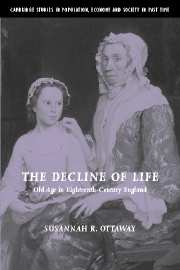Book contents
- Frontmatter
- Contents
- List of figures
- List of tables
- Acknowledgments
- List of abbreviations
- Introduction: Old age in eighteenth-century England: no “golden age of aging”
- 1 Who was “old” in eighteenth-century England?
- 2 The activities of the “helmsman”: self-reliance, work, and community expectations of the elderly
- 3 “The comforts of a private fire-side”
- 4 Independent but not alone: family ties for the elderly
- 5 Community assistance to the aged under the Old Poor Law
- 6 Continuity and change in community assistance to the elderly over the eighteenth century
- 7 Within workhouse walls: indoor relief for the elderly
- Conclusion: Old age as a useful category of historical analysis
- Bibliography
- Index
6 - Continuity and change in community assistance to the elderly over the eighteenth century
Published online by Cambridge University Press: 15 December 2009
- Frontmatter
- Contents
- List of figures
- List of tables
- Acknowledgments
- List of abbreviations
- Introduction: Old age in eighteenth-century England: no “golden age of aging”
- 1 Who was “old” in eighteenth-century England?
- 2 The activities of the “helmsman”: self-reliance, work, and community expectations of the elderly
- 3 “The comforts of a private fire-side”
- 4 Independent but not alone: family ties for the elderly
- 5 Community assistance to the aged under the Old Poor Law
- 6 Continuity and change in community assistance to the elderly over the eighteenth century
- 7 Within workhouse walls: indoor relief for the elderly
- Conclusion: Old age as a useful category of historical analysis
- Bibliography
- Index
Summary
The historical literature surrounding the Old Poor Law has stressed repeatedly that the most important development in eighteenth-century England's welfare system was the growth in assistance to laborers' families at the end of the century. This focus has served to conceal completely another transformation in the role of poor relief that occurred over the eighteenth century. The parish's role in supplying economic support to its elderly members changed from that of a very strong safety net that extended over a relatively small area to a far-flung but all too weak-fibered net strained to breaking point. The growth in the scope of community relief to the aged is important for our understanding of the history of retirement, social welfare, and the social history of the eighteenth century more generally.
The previous chapter described the system of poor relief as it functioned towards the end of the century in several parishes. Here, the focus is on the ways that poor relief to the elderly under the aegis of the Old Poor Law changed over the course of the eighteenth century with special reference to the parishes of Terling and Puddletown. Two vital changes in community care to the elderly emerge: poor relief to the elderly expanded in the sense that more aged individuals relied on the poor rates at the end of the eighteenth century.
- Type
- Chapter
- Information
- The Decline of LifeOld Age in Eighteenth-Century England, pp. 221 - 246Publisher: Cambridge University PressPrint publication year: 2004



